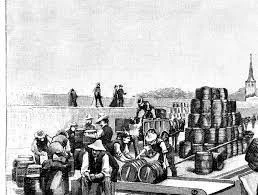
Did you know the term supply chain is attributed to a 1905 publication of a newspaper, “The Independent”? Supply chain has enjoyed a rich history, and in this article, we review some of the evolution of supply chains
In 1982, Keith Oliver, a consultant at Booz Allen Hamilton, coined the term supply chain management.
Before 2020, most of the world had no idea what supply chain or supply chain management was. Today everyone seems to have an opinion about it.
However, supply chain is not a new concept. Its history dates thousands of years and has played major roles in ancient and modern civilization.
While so many people are still trying to understand it, why not share some historical supply chain facts?
1. Supply chain-related activities date back thousands of years
The early stages of the evolution of supply chains-related activities, such as production, construction, and logistics, date back to ancient empires across the globe.
Ancient empires across the globe, such as Egypt, Peru, Persia, Assyria, and the Roman Empire, all made their imprints in different ways in the development of supply chains.
These empires were responsible for the development of road networks and organized transportation schemes to aid trade and conquests.
2. Wars and military reforms largely sparked Supply chain innovations
Advancements in supply chains have been mostly rooted in the military. Wars and conquests made supply chain and logistics innovation possible.
While horses were good for the Transportation of humans, they were extremely limited in the Transportation of goods.
Military challenges such as this gave birth to wheels and ships and has seen various advancements in air technology.
3. Globalization of the supply chain has its roots in the invention of large ships during the 18th century.
Although the supply chain had been around for a long time, it had remained static. For a long time, different aspects of the supply chain were mostly local, stagnating growth.
The reason for the localization of the supply chain was primarily because of the lack of transportation infrastructure, which made it difficult for people to move goods.
In the 18th century, things began to change.
With the invention of larger transportation services like expanded shipping capabilities, trade grew exponentially, laying the groundwork for what will later be a global supply chain.
4. Railroads revolutionized Transportation
Ships were great for the globalization of the supply chain, but trains helped connect large spans of areas connected by land.
In the 19th century, trains were welcome with open arms and awe. Transportation of resources and people had never been safe, faster, and less expensive.
With railroads came the creation of time zones to better track departures and arrivals from station to station.
With the trains came the increasing demand for goods and services, sowing the seeds for an increasingly interconnected world.
5. Supply chain management became a concept in the 20th century.
Before the 20th-century evolutions, supply chains mainly consisted of trade. There was production but on a low scale.
People like Andrew Carnegie revolutionized the steel industry towards the end of the 19th century. He did this by bringing together and managing different arms of his supply chain.
In the late 1920s, though he faced many challenges, Henry Ford took this a step further.
The introduction of mass production, especially along assembly lines, laid the foundation for what we would all come to acknowledge as Supply chain management.

Obinabo Tochukwu Tabansi is a supply chain digital writer (Content writer & Ghostwriter) helping professionals and business owners across Africa learn from real-world supply chain wins and setbacks and apply proven strategies to their own operations. He also crafts social content for logistics and supply chain companies, turning their solutions and insights into engaging posts that drive visibility and trust.








